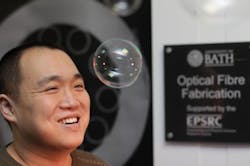Hollow-core, gas-filled fiber laser reaches 3 micron mid-IR region
University of Bath (Bath, England) Department of Physics researchers have created a new kind of hybrid fiber laser capable of pulsed and continuous mid-infrared (IR) emission between 3.1 and 3.2 microns--a spectral range that has long presented a major challenge for laser developers.
RELATED ARTICLE: Gas lasers: Durable survivors evolve new forms
The achievement could aid in the development of new uses for mid-IR lasers currently used in applications such as spectroscopy, environmental sensing, and explosives detection. Described in the Optical Society's journal Optica, the hybrid laser combines aspects of both gas and fiber lasers.
Placing a suitable gas inside of a hollow optical fiber (or microstructured or photonic crystal fiber) allowed the researchers to create a fiber gas laser with mid-IR emission. "Beyond about 2.8 microns, conventional fiber lasers start to fall off in terms of power, and the other main technology for the mid IR, quantum cascade lasers, doesn't pick up until beyond 3.5 microns," said William Wadsworth, who co-led the research team with Jonathan Knight, also at the University of Bath. "This has left a gap that has presented a great deal of difficulty."
Key to the laser's success was the team's development of silica hollow-core fibers that perform exceptionally well in the mid-IR region. "You can think of the structures in our fibers as very long and thin bubbles of glass," explained Wadsworth. "By surrounding the region of space in the middle of the fiber with the bubbles, light that is reflected by the bubbles will be trapped inside of the hollow core."
Because light traveling inside a hollow-core fiber remains mostly in the empty core, these fibers overcome the tendency of silica-based glass to absorb light at wavelengths past 2.8 microns. The researchers used acetylene gas because it emits in the mid-IR and can be excited, or pumped, using lasers designed for the telecommunications industry. The hollow-core fibers provided a way to trap the light and the gas in the same place so that they can interact for a very long distance--10 or 11 m in this case.
The Bath researchers as well as other research groups have previously shown that gas inside a fiber can interact with light to produce mid-IR emission. In the new work, the researchers added a feedback fiber, the last component needed to consider the device a true laser. The feedback fiber takes a small amount of light produced in the fiber containing the acetylene gas and uses that light to seed another cycle of light amplification, thus reducing the pump power required to produce a laser beam.
"We developed a way to use light to pump molecules and generate light that is not that common to see in a laser system," said Fei Yu, a member of the research team. "This new way to construct a gas laser could be expanded to make more and more laser types that would have been impossible without our hollow-core fiber."
The researchers say that a number of other gases should work with their fiber gas laser, allowing emission up to 5 microns. "This laser is just one use of our hollow-core fiber," said Muhammad Rosdi Abu Hassan, a doctoral student and first author of the paper. "We see it stimulating other applications of the hollow fiber and new ways of interacting different types of laser beams with gases at various wavelengths, including wavelengths that you wouldn't expect to work."
SOURCE: University of Bath; http://www.bath.ac.uk/research/news/2016/02/29/gas-laser/
About the Author

Gail Overton
Senior Editor (2004-2020)
Gail has more than 30 years of engineering, marketing, product management, and editorial experience in the photonics and optical communications industry. Before joining the staff at Laser Focus World in 2004, she held many product management and product marketing roles in the fiber-optics industry, most notably at Hughes (El Segundo, CA), GTE Labs (Waltham, MA), Corning (Corning, NY), Photon Kinetics (Beaverton, OR), and Newport Corporation (Irvine, CA). During her marketing career, Gail published articles in WDM Solutions and Sensors magazine and traveled internationally to conduct product and sales training. Gail received her BS degree in physics, with an emphasis in optics, from San Diego State University in San Diego, CA in May 1986.
